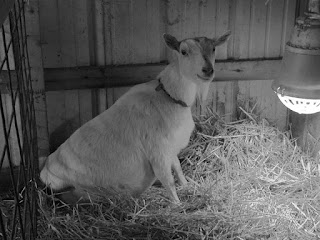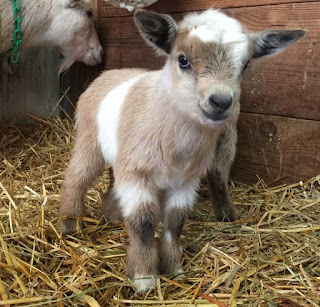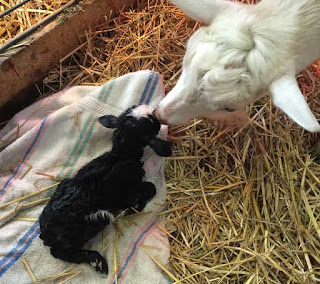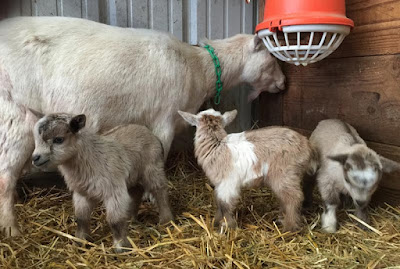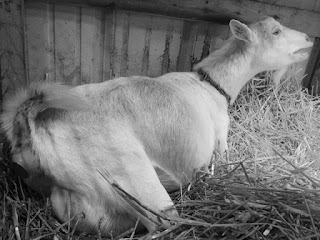Before I tell you this story, I have to tell you that we've had twelve does give birth so far this year, and ten of them were textbook perfect. Now I'm really wishing I had been able to find the time to write about those joyful, beautiful births.
On April 18, I happened to look out the window by my desk, and I saw Alex laying on the ground in an unmistakable position. Her legs were outstretched, her neck was craned, and her ears were pointed back. She was in labor and pushing. I jumped up, grabbed a stack of goat towels that just happened to be next to the front door and ran to the pasture. It seemed like a beautiful spring day to have a goat give birth in the pasture.
As soon as I opened the gate, Lucy the Great Pyrenees ran towards me, and as I approached Alex, the dog's exuberance caused the goat to stand up and start walking away. I put Lucy into another pasture and went back to Alex. Of course, I was wearing a pair of my town jeans, which means that they didn't have any farm stains on them, such as manure, dirt, or blood.
Beauty the Jersey cow also happened to be in the pasture, and she decided to come say hi. She has recently decided that I'm her new scratching post, and she started to rub her head against me. I called Sarah who was in the barn working on a building project, and she came out and moved Beauty to the next pasture. Then she brought a flake of straw so that I could scatter it on the ground because Alex had chosen to lie down in a spot with more dirt than grass.
The first kid was very slow to come out, partly because Alex wasn't pushing very hard, and partly because he was quite large. I'd later discover that he was 4 pounds, 7 ounces, which is big for a Nigerian, where 3 pounds is more average. Because her contractions seemed to be really wimpy and the kid was making little to no progress from one contraction to the next, I pulled on his legs to help bring him into the world.

I could see that the second kid was even bigger when the first hoof emerged. I kept comparing it to the hoof of the kid that had already been born and was worried. As the nose and white head began to come out, it was easy to see that there was an unusual amount of blood. (I took the picture at right after I'd toweled him off and removed as much blood as I could.) Turns out he weighed 5 pounds, 2 ounces, setting a new record for largest Nigerian kid born on the farm. Because he was also progressing excruciatingly slowly, I wound up pulling him also, and it was such a tight squeeze that Alex was even pulled across the grass a little.
After the kids were born, I started to worry even more, as Alex completely ignored them. She's an experienced mom and has always been wonderful with her kids. We took her and the bucklings into the barn, and not only would she not let them nurse, but she wouldn't let me milk her. This is a doe who just finished a three-year lactation two months ago, so she's also a very experienced milker! She just wanted to lay in the stall with her ears back, looking angry.
I was supposed to pick up two bee nucs (starter hives of live bees) right about the time that Alex went into labor, but I messaged the bee person and told him why I was running late. I felt very conflicted, as I really needed to pick up the bees and bring them home, but I was also worried about Alex. I checked her temperature, and it was only 101.5, which is a little on the low side, but probably not low enough to assume she had milk fever. She wasn't eating until we gave her Power Punch, which is an electrolyte and molasses concoction. I couldn't check her for ketones because that would require catching her urine, and she wasn't standing up, so I'd have no idea when or if she peed.
She hadn't passed her placenta, and there was not much hanging out in terms of membranes, so I was not completely convinced that she didn't have another kid inside because she was still pushing ever few minutes. I've never seen a doe really "push" if the only thing left was the placenta. I decided to do an internal exam to check for a retained kid, but there wasn't one.
Because she wouldn't stand up and let the kids nurse, I eventually was able to milk out her colostrum and give it to the bucklings in a bottle. At least they were doing well.
I called the U of I vet hospital and spoke to a vet who said that it sounded like Alex might just be in pain because the kids were so unusually large. So, I jumped in my car and went to pick up the bees and bring them home. There was a farm supply store on my route, so I stopped and picked up some CMPK to treat for possible milk fever, which is caused by a calcium deficiency.
The next morning I knew something was wrong. Her temperature was down to 99, which either meant that it was definitely milk fever or her body was shutting down and she was dying. I put her in the car and headed for the university vet hospital.
Within a couple of hours, an ultrasound and blood tests, we learned that she had metritis and was acidotic. Thankfully she didn't have ketosis or hypocalcemia (milk fever). They thought that they might see a very small mummified fetus in her uterus, but they weren't sure because you can only make educated guesses on an ultrasound. They said she probably had the metritis before she even went into labor, which would explain why she had such wimpy contractions and why I had to pull the kids and why she still hadn't passed her placenta 24 hours later. They still didn't have all the answers though, and Alex was in terrible condition, so I left her a the vet hospital and headed home.
After I left they had a couple of reproductive specialists do another ultrasound, and they don't think there was a retained mummified kid. They thought it looked more like a uterine tear. But they are all in agreement that she had an infection before she even went into labor. The vet said she's gotten worse since I left, so they're actually giving her morphine on top of the banamine. They also started her on an oxytocin drip, hoping that would help her expel the placenta.
I think the reason her temp was so low that morning is because she was shutting down. She really looked like she was just ready to die, so it was hard for me to imagine that she looked worse after I left. They said that if she had a uterine tear, the day after the birth was always the worst, and that if she was going to make it, she should improve a lot by the following day.
The next day they had a reproductive specialist do an ultrasound and a vaginal exam, and he said that she has an interior vaginal tear, which went all the way through into her abdomen, and that could ultimately cause more problems than a uterine tear. The vet said "Goat uteruses love to tear. It's just what they do. But they're also really good at healing themselves." Vaginal tears can wind up with a lot of scar tissue that would cause kidding problems in the future. If we wanted to breed her again, they suggested bringing her back in 30 days for another exam to see if scar tissue is building up and looks problematic. That was another first for me! I'd never heard of an interior vaginal tear, but that's probably why the 5-pound, 2-ounce kid had so much blood on his head when he was being born.
Alex continued to improve, and I was able to bring her home after five days in the vet hospital. On the phone, the vet told me how much better she looked, but when I arrived, I thought she looked dreadful. After I brought her home and put her in the barn with her kids, she just laid there all the time with her ears back, and she'd still push every few minutes. They said that was because of the internal tear. Every time I looked at her, I kept thinking that she might still die. I'd never seen a goat look so miserable, and I just kept reminding myself that we'd done everything possible.

I put her in the kidding stall with her bucklings, which we'd been bottle-feeding. I simply hoped she'd tolerate them, but it seemed that she remembered them as she would lick them when they came near her. Three days after she came home, she finally started standing up to eat. As I was giving one of her boys a bottle one evening, the other one was bopping my leg, hoping to find a new spigot for milk. Since Alex had been tolerating them quite well, I decided to give it a try and see if she'd let the kid nurse.
I sat down in the straw and put the kid under her. I put the teat in his mouth while squeezing out a bit of milk onto his tongue. He immediately began to suckle! I supported his head for a minute or so, then I let go, and he continued to nurse, and Alex just stood there like a perfect mama! The other kid, who had already had a bottle, wasn't interested, so I decided to let him try nursing in the morning before giving him a bottle.
The next morning I was so excited about the possibility of the second kid starting to nurse but reminded myself that it might not work.
Don't get your hopes up too much, I told myself. When I walked into the kidding pen, I checked the tummy on the kid who had nursed the night before, and it was quite full. I felt Alex's udder, and it was loose. We had been milking her, so I knew it would have been much more full if the kid had not been nursing.
I sat down and put the other buckling in front of Alex's udder and opened his mouth, just as I'd done for his brother. He also began suckling immediately! I was over the moon excited, and the song "Miracle's Happen" from Princess Diaries immediately began playing in my head. Indeed, if anyone had asked me if this was possible, I would have said that I never say never, but I wouldn't get my hopes up about kids starting to nurse at eight or nine days of age.
Alex has continued to improve, and we recently moved her and her bucklings into a nursery pen with two other does and their kids, and Alex immediately decided she should be the queen of this little herd. She took on the other two does in quite the head butting match and won.
We have no plans to ever breed her again, as I'm not going to trust a visual exam to determine whether or not she'd be able to give birth vaginally in the future. Her last lactation lasted three years, and she is six years old now, so we will just continue to milk her and see how long she can go.




















